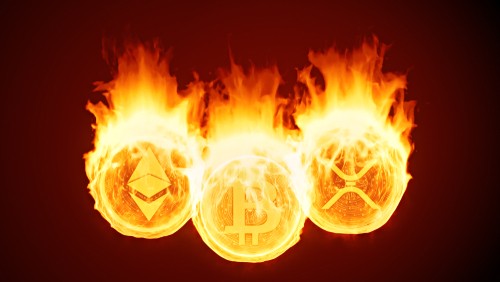
Summary
- “Burning” crypto means permanently removing a number of tokens from circulation.
- The motivation is often to increase the value of the remaining tokens since assets tend to rise in price whenever the circulating supply falls and they become more scarce.
- Burning tokens can also benefit those staking tokens to validate transactions in a proof-of-stake protocol. When a large chunk of tokens are removed from circulation, there’s a likely chance they’ll receive a higher U.S. dollar value from their staking rewards.
- A version of this article first appeared on Coindesk. Read more Crypto Council explainers.
“Burning” crypto means permanently removing a number of tokens from circulation. Crypto burning is typically done by transferring the tokens in question to a burn address, i.e. a wallet from which they cannot ever be retrieved. This is often described as destroying tokens.
A project burns its tokens to reduce the overall supply. In other words, it creates a “deflationary” event. The motivation is often to increase the value of the remaining tokens since assets tend to rise in price whenever the circulating supply falls and they become more scarce.
In a similar way, algorithmic stablecoins automatically mint new tokens and burn them frequently to maintain their dollar-pegged value. For example, if demand for the stablecoin rises and the price diverges above its dollar peg, the protocol’s smart contract will automatically issue a number of new tokens to bring the price back down, and vice versa.
Burning tokens can be similar to a company buying back its shares. The company “returns the value” to its shareholders in this way. Crypto projects burn their tokens to achieve the same goal.
The price of the token does not necessarily increase overnight when the burn takes place. Sometimes, other news about the token can overwhelm the impact. Alternatively, investors may know a token burn is going to happen and “price it in” at an earlier point. Even so, in the long run, burning tokens tend to support an asset’s price and is considered a positive move.
Burning tokens can also benefit those staking tokens to validate transactions in a proof-of-stake protocol. When a large chunk of tokens are removed from circulation, there’s a likely chance they’ll receive a higher U.S. dollar value from their staking rewards.
Some projects have regular crypto burning events built into their code. The aim here is to reassure potential investors that the future supply of the token will continue to shrink, calming concerns of inflation or an overly diluted market. As a result, this practice can also add to the appeal of a token as a “store of value.”
The Terra project, for example, burned 88.7 million of its LUNA tokens in November 2021. The tokens represented around $4.5 billion in value at the time, which the company said made the event one of the largest layer 1 token burns ever. The move was passed by a vote in the Terra community. The LUNA token set a new record high price in the following days. The purpose of the burn was partly to remove value from Terra’s community pool, where founder Do Kwon argued it was not needed. In a sense, the burn transferred value from the pool to individual holders of the token.




